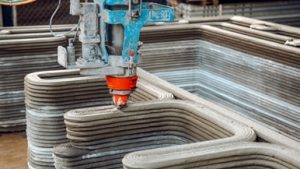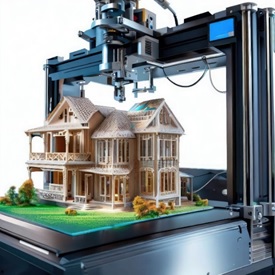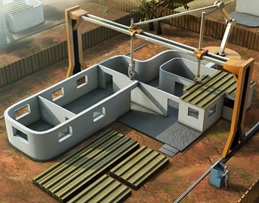In the ever-evolving landscape of construction and real estate, a revolutionary technology is making waves and promising to reshape the very foundations of how we build our world. 3D printing, once confined to small-scale prototyping and hobbyist endeavors, has grown to encompass entire buildings, offering a glimpse into a future where homes and offices can be ‘printed’ in a matter of days or even hours. This additive manufacturing approach to construction is not just a futuristic concept; it’s a present reality that’s already generating profits and transforming the industry.
At its core, 3D printing in construction works much like its smaller-scale counterparts. A large, computer-controlled machine extrudes building material – typically a special type of concrete – layer by layer, gradually forming walls and structures according to a pre-programmed design. This process, often referred to as ‘contour crafting,’ allows for the creation of complex geometries that would be difficult or impossible to achieve with traditional construction methods.
The implications of this technology are far-reaching and multifaceted. For starters, 3D printing dramatically reduces construction time. What might take months using conventional building techniques can be accomplished in weeks or even days with 3D printing. This allows for faster return on investment as properties can be completed and occupied more quickly. Labor costs, a significant portion of any construction budget, are substantially reduced with 3D printing.
While skilled operators are still needed to manage the printing process and finish the buildings, the bulk of the labor-intensive work is handled by the printer itself. This reduction in manual labor not only cuts costs but also addresses the ongoing skilled labor shortage in the construction industry.
still needed to manage the printing process and finish the buildings, the bulk of the labor-intensive work is handled by the printer itself. This reduction in manual labor not only cuts costs but also addresses the ongoing skilled labor shortage in the construction industry.
The environmental benefits of 3D printed construction are also noteworthy. The process produces significantly less waste than traditional construction methods. In conventional building, it’s common for 10-15% of materials to end up as waste. With 3D printing, the exact amount of material needed is used, with minimal excess. Additionally, many of the concrete mixtures used in 3D printing are designed to be more environmentally friendly than traditional concrete, with some companies experimenting with recycled materials and lower-carbon alternatives.
But perhaps one of the most exciting aspects of 3D printed construction is the design freedom it offers. Architects and designers are no longer constrained by the limitations of traditional building techniques. Curved walls, complex geometric patterns, and unique architectural features can be ‘printed’ just as easily as straight walls. This opens up new possibilities for creating homes and buildings that are not just functional, but truly works of art.
The potential for customization is enormous. In a 3D printed world, the cost difference between a standard design and a completely custom home could be negligible, as the printer doesn’t care whether it’s producing a simple cube or an intricate castle-like structure.
As the technology continues to evolve, we’re likely to see innovations in materials science that could further enhance the capabilities of 3D printed construction. Imagine buildings that can heal themselves when damaged, or structures that can adapt to their environment, expanding or contracting based on weather conditions or occupancy needs.
For investors and entrepreneurs in the real estate and construction sectors, 3D printing represents both an opportunity and a challenge. Those who embrace this technology early and find innovative ways to apply it could see substantial returns. However, it also means that existing business models may need to evolve to remain competitive in this new landscape.
As with any transformative technology, the full impact of 3D printing on construction and real estate will only become clear as it matures and is adopted more widely. What is certain, however, is that it offers exciting possibilities for creating a built environment that is more efficient, sustainable, and tailored to human needs. For those in the construction and real estate industries, now is the time to start exploring how this technology might shape the future of building – and how to position oneself to profit from this additive manufacturing revolution.


The best finance option: www.Seaportcredit.ca


